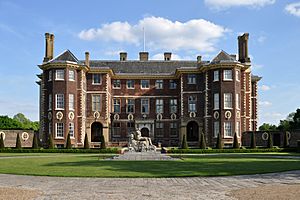William Tollemache, 9th Earl of Dysart facts for kids
Quick facts for kids William Tollemache |
|
|---|---|
|
|
|
| Reign | 1878–1935 |
| Predecessor | Lionel Tollemache, 8th Earl of Dysart |
| Successor | Wenefryde Scott, 10th Countess of Dysart |
| Spouse(s) | Cecilia Florence |
| Father | William Tollemache, Lord Huntingtower |
| Mother | Katherine Elizabeth Camilla Burke |
| Born | 3 March 1859 |
| Died | 22 November 1935 |
William John Manners Tollemache, 9th Earl of Dysart (born March 3, 1859 – died November 22, 1935) was an important figure in Scottish nobility. He held the title of Earl of Dysart and was also a Baronet. He served as the Lord Lieutenant of Rutland from 1881 to 1906, which meant he was the King's representative in that area. He was also a Justice of the Peace in Leicestershire and Lincolnshire, helping to keep law and order.
Contents
William's Early Life
William Tollemache was the oldest son of William Tollemache, Lord Huntingtower. His mother was Katherine Elizabeth Camilla Burke. William had three older sisters. He also had other half-siblings from his father's earlier relationships.
Managing the Family's Estates
William's grandfather, Lionel Tollemache, 8th Earl of Dysart, passed away in 1878 when William was 19. To protect the family's wealth, his grandfather set up a special arrangement. He left his estate to William, but it was held in a trust for 21 years. This meant a group of people called trustees managed the money and property.
The first trustees were William's great-uncles, Algernon Gray Tollemache and Frederick James Tollemache. Frederick's son-in-law, Charles Hanbury-Tracy, 4th Baron Sudeley, was also a trustee. These trustees worked to manage the family's investments and properties. They continued to oversee many of the family's financial matters even after the 21-year trust period ended.
William's Marriage
In late 1885, William married Cecilia Florence. She was the daughter of George Onslow Newton. William and Cecilia did not have any children. Lady Dysart later lived separately from William in London. He did not marry again after her death in 1917.
William's Interests and Hobbies
Lord Dysart had two main homes: Ham House in Petersham, Surrey, and Buckminster Park in Leicestershire. After his grandfather's death, William started work to restore Ham House. The house had become quite old and needed repairs.
William was partially sighted from birth and became blind for most of his life. However, this did not stop him from living a very active life. He traveled a lot, visiting places in Europe, Russia, and Egypt. He also enjoyed riding horses. He would ride with a special leading rein held by a groom.
He loved music, especially German opera. He went to the Bayreuth Festival every year, which is a famous music festival. He was also the president of the London Wagner Society for many years. He even asked a composer named Ferdinand Praeger to write a book about the famous composer Richard Wagner.
William mostly stayed at Ham House. He would go to Buckminster Park from September to January for weekend shooting parties. After his wife moved out, his niece, Mrs. Hack, and her daughters joined him at Ham. They helped host many social events there. One important event was a coming-out ball for his niece, Wenefryde Scott.
Managing the Estates and Land
Under the trustees' management, the family's land grew. The trustees bought more property around Ham and Petersham. Eventually, the Dysart family owned 70% of that area. As London grew, there was a high demand for building land.
The family successfully ended old farming rights on about 176 acres of open farmland in Ham. This was done through a special law called the Richmond, Petersham and Ham Open Spaces Act in 1902. Instead of building houses on all the land, much of it was leased to a company that extracted gravel. This gravel was used for construction projects.
The Dysart family also developed their land in the nearby area of Canbury for housing. This happened as Kingston expanded north. During World War I, the Dysarts sold some land in Ham to the government. This land was used to build a factory that made aircraft parts. This factory also increased the need for housing in the local area.
Death and Who Came Next
William Tollemache passed away on November 22, 1935. After his death, his Scottish title, the Earl of Dysart, went to his niece, Wenefryde Scott. His British baronetcy, another noble title, was inherited by his second cousin, Sir Lyonel Tollemache, 4th Baronet. William also left Ham House to Sir Lyonel.
Images for kids



